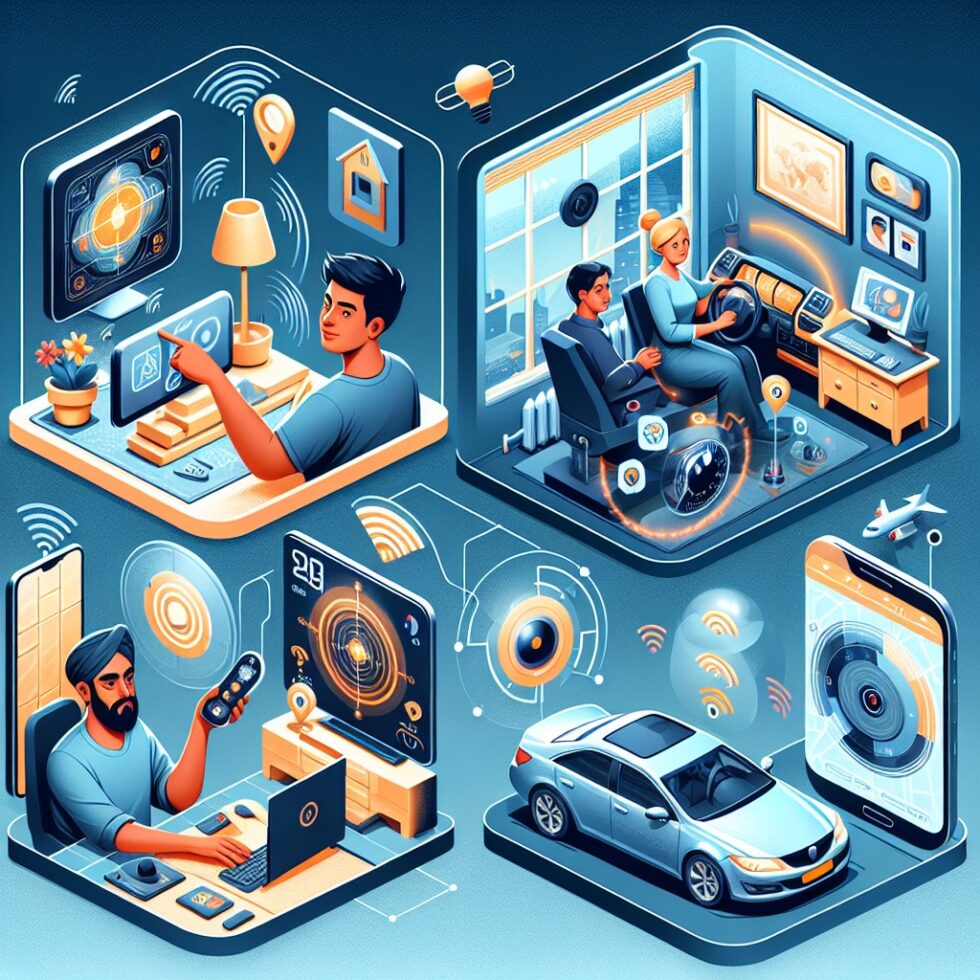
Why Radar Is Suddenly Everywhere
Look around and you might not see them, but you’ll feel what they do. Your laptop wakes the instant you sit down. The room cools before a meeting starts. Your car checks if someone is in the back seat. Quiet, fast, and private by default, millimeter-wave (mmWave) radar is moving into everyday objects.
Unlike cameras, radar doesn’t capture images. It emits radio waves and reads the reflections. That means it works in the dark, through fabrics, and behind objects. It also means less personal detail leaves your device, which makes privacy-conscious sensing possible. The hardware is shrinking, the cost is dropping, and developers have better tools than ever.
This guide explains how consumer radar works, where it’s useful, and how to design with it safely and responsibly. We’ll keep the language clear and the steps practical, whether you’re choosing a smart presence sensor for your home or planning a product with radar inside.
How mmWave Radar Works (Without the Math Headache)
All radars send out radio energy and listen for echoes. The type now appearing in consumer devices is usually FMCW—Frequency Modulated Continuous Wave—operating most often at 60 GHz for rooms and 77–81 GHz for vehicles.
Range and Motion from a Single Chip
Here’s the simple picture:
- The chip transmits a tiny “chirp” that ramps in frequency.
- It receives the reflection from objects. The delay tells you distance.
- Small shifts in the frequency of the echo tell you motion (Doppler).
- Multiple antennas let the device estimate the direction of targets.
With just a few square millimeters of silicon and printed antennas, you get a point cloud of “objects” in a scene: their range, speed, and angle. This is enough for presence detection, gesture sensing, sleep tracking, and even child detection in cars.
Micro‑Doppler: The Secret Sauce for Subtle Motion
Radar doesn’t need a person to walk around to notice them. The tiny motions of breathing and hand tremors create a signature known as micro‑Doppler. That lets a sensor tell if a person is sitting still, asleep, or waving a hand. It’s also how some smart displays can track sleep without a wearable and how office sensors can tell the difference between an empty chair and a quiet person at a desk.
Why 60 GHz and 77–81 GHz?
Higher frequencies deliver finer detail and smaller antennas. The 60 GHz band is often used indoors for presence and gestures; the 77–81 GHz band is standard in automotive radar for longer range and speed. Both are non‑ionizing, regulated, and safe at consumer power levels. They are not Wi‑Fi. They’re purpose‑built sensing bands with power and bandwidth rules that enable reliable, low‑interference operation.
Where You’ll Encounter Radar Next
Radar has been in cars for years. What’s new is its march into home devices, laptops, and public spaces. Here’s what it’s good at, and where it struggles.
At Home: Presence, Comfort, and Calm
Presence sensors used to rely on PIR (passive infrared), which misses people who sit still. mmWave presence sensors see subtle motion, so lights stay on and HVAC can adapt quietly. They’re sensitive enough to detect a reading person in a corner or someone napping on the couch. Practical uses include:
- Energy savings: Heat or cool only occupied rooms. Fine‑tune by area, not just whole floors.
- Sleep tracking without wearables: Bedside devices read micro‑motions from breathing and subtle shifts, with no camera at all.
- Fall awareness: A sudden collapse pattern stands out from normal movement, helping trigger alerts.
- Gesture control: Wave to dismiss a timer or pause music without touching anything.
Radar’s weaknesses at home: it can see through light materials, so you must tune zones to avoid sensing beyond walls; mirrors and metal can create reflections that confuse simple detectors; and pets complicate occupancy counts unless your model knows better.
On Your Desk: Human Presence That Respects Privacy
Laptops and monitors now include human presence sensors that lock when you leave and wake when you return. The user experience feels magical: no camera shutter to worry about, no face data uploaded. A good design balances sensitivity with “don’t wake up just because someone walked past behind you.” Desktop radars can also dim the screen when you turn away and brighten when you look back, saving power without a camera watching your face.
In Cars: Beyond Collision Avoidance
Automotive radar is best known for adaptive cruise control and blind‑spot monitoring. New cabin applications include child presence detection (tiny chest motions show life even under a blanket) and occupant monitoring for airbag decisions. Exterior radars at the corners can also detect cyclists and pedestrians for lane changes. Unlike cameras, radar works in fog, rain, and darkness; unlike ultrasonics, it reaches further and sees motion clearly.
Quiet Intelligence in Public Spaces
Occupancy analytics in offices and stores often need counts, not identities. Radar gives you anonymous occupancy by default. It can tell how many people are in a conference room and how quickly a space fills up after a class ends, without recording faces or voices. The tradeoff is it won’t tell who was there. That’s a feature for privacy, but it requires careful design in systems that might tempt you to cross‑reference other data sources.
Designing with Radar: Practical Steps That Work
If you’re building a product or a DIY project with radar, here is a manageable path from idea to reliable behavior.
Choose the Right Module
- Short‑range presence (indoor): 60 GHz modules from vendors like Infineon and Acconeer. They’re small, low power, and tuned for room‑scale sensing and micro‑motion.
- Automotive and longer range: 77–81 GHz modules and evaluation boards from vendors like Texas Instruments. They offer richer beamforming and higher range/velocity resolution.
- Antennas matter: Field of view, side lobes, and placement change everything. Read the module’s antenna pattern and design for the room geometry.
Start with a Simple Pipeline
You don’t need deep learning on day one. Work in stages:
- Range–Doppler map: Compute it and visualize. It shows distance and motion in a 2D image. The “quiet” areas tell you about noise and reflections.
- CFAR detection: A simple adaptive thresholding method that flags moving targets without fixed limits.
- Clustering: Group detections into “objects” and track them over time. Even basic tracking smooths false blips.
- Micro‑motion features: For presence and sleep, extract low‑frequency motion from a fixed range bin. You’re watching for breathing‑like periodicity.
Only after this should you consider a small classification model to separate a pet from a person or to recognize a handful of hand gestures. Keep it edge‑first so raw signals never leave the device.
Calibrate for the Real World
- Placement: Mount the sensor where it “sees” the space you care about but not adjacent rooms. Ceiling mounts often work best for presence coverage.
- Zones and masks: Define exclusion zones in software to ignore known reflective surfaces (e.g., a metal cabinet) and areas outside a room.
- Motion thresholds: Tune for low false alarms but true detection when someone is sitting still. Start conservative, then relax as you learn the environment.
- Time horizons: For energy control, you usually want fast detection on entry and slower timeouts on exit to avoid flicker.
Integrate with the Rest of the System
Radar doesn’t live alone. It should feed into lighting, HVAC, and notification systems. Aim for:
- Standard protocols: Use local messaging (e.g., MQTT) and well‑supported home or building controllers so your radar can outlive any cloud service.
- Fail‑safe behavior: If the sensor goes offline, fall back to schedules. Don’t leave rooms in the dark or HVAC stuck in away mode.
- Edge updates: Keep firmware updatable for security and improvements. Make the update process transparent to users.
Privacy and Safety: Getting It Right from the Start
Radar wins fans because it senses without “seeing.” That’s a good baseline, but it’s not the end of privacy work. Do these things and say them clearly to users.
Privacy by Design for Radar
- Process at the edge: Keep raw IQ data, range‑Doppler maps, and point clouds on the device. Send only events or summaries (e.g., “occupied,” “empty,” “two targets”).
- Short retention: If you store motion histories, keep them tight and local. Many use cases only need minutes, not months.
- Clear controls: Offer a hardware off switch or a mode that blanks transmissions. Show visible status when sensing is active.
- No covert fusion: Don’t silently combine radar traces with other personal data to infer identities. If you must fuse signals (e.g., occupancy + HVAC), make it explicit and minimal.
RF Safety and Regulations
mmWave radar in consumer devices transmits at very low power and is non‑ionizing. It does not have the energy to break chemical bonds like X‑rays. Devices must comply with regional rules on frequency, bandwidth, and power. Responsible designs pass certification before shipping and default to legal power levels that are far below typical Wi‑Fi or cellular use.
Security Basics Matter
Like any connected device, radar sensors can be targets. Lock down your endpoints:
- Local, authenticated APIs: Avoid insecure web panels. Use TLS and device‑unique credentials if remote access is required.
- Minimal attack surface: Turn off unneeded services. Expose only control endpoints and events.
- Signed firmware: Ship secure boot and signed updates to prevent tampering.
What Radar Is—and Isn’t—Good At
Radar excels at sensing motion, presence, and coarse positions. It falls short for identification, detailed posture, or reading screens. That’s not a weakness; it’s a boundary that helps teams design the right combinations of sensors.
Strengths
- Privacy by default: No images. No faces.
- Works in the dark: Nighttime and low light are fine.
- Sees through fabrics: Blankets and thin walls don’t hide breathing or movement.
- Low compute: Useful results without a GPU. Great for embedded designs.
Limitations
- Ambiguity: Two people close together can merge into one “blob” without advanced processing.
- Reflections: Mirrors and metal can create ghost targets and multipath.
- No identity: It won’t tell who someone is. That’s often a pro, but it constrains application design.
Practical Use Cases You Can Deploy Today
Smarter Rooms Without Cameras
Drop‑in presence sensors make lights and HVAC feel human‑aware. Choose models with zoning so you can avoid sensing through walls and define “safe” areas for pets. Pair with daylight sensors so you don’t switch lights on when the room is bright already. Add a short exit grace period to keep lights from flicking off during quiet moments.
Sleep and Recovery Insights
If you dislike wearables at night, radar can analyze breathing rate variability and movement to estimate sleep stages. The best setups keep raw signals local and expose only high‑level sleep metrics. Treat those as trends, not medical diagnostics. Focus on bedtime consistency and environment control (light, temperature, noise), then use radar insights to fine‑tune routines.
Safer Cars and Garages
Interior radars can detect a child or pet left in a car by sensing micro‑motion. Exterior radars extend blind‑spot monitoring into low‑speed maneuvers, seeing cyclists or pedestrians approaching from behind a parked vehicle. In home garages, a small radar can double as a precise parking assistant that doesn’t depend on old ultrasound pucks or scuffed tennis balls.
Office Presence with Real Privacy
Swap desk cameras for radar‑based presence modules. Laptops can lock and wake without capturing faces. Meeting rooms can report “occupied” without logging attendees. Facilities teams get accurate occupancy patterns while employees keep their privacy. That’s a win for trust, security, and energy savings.
A Quick Guide for Builders and Buyers
For Builders
- Define the question: “Occupied or not?” is a different pipeline than “count people” or “recognize gestures.” Pick one and do it well first.
- Prototype visibly: Show live range‑Doppler maps to your team. Visualizing helps debug zones and thresholds fast.
- Harden the edge: Ship with on‑device classification and keep cloud traffic to events or aggregate stats.
- Document privacy: Write a one‑page plain‑language overview of what the sensor does, stores, and sends. Put it in the box.
For Buyers
- Check the band: 60 GHz is typical for rooms; 24 GHz and 77–81 GHz show up in specialized products.
- Look for zoning: Good sensors let you draw inclusion/exclusion areas. That reduces false positives.
- Ask about updates: Security updates and support timelines matter for any connected device.
- Prefer local control: Bonus points for offline behavior and integrations that don’t require a cloud account.
What’s Next: Smarter Models, Sharper Beams, Simpler APIs
Three trends will shape radar’s next few years in everyday tech.
Edge ML That Makes Fewer Mistakes
Developers are training compact models on radar point clouds and micro‑Doppler traces. These models distinguish sitting humans from pets or fans and can recognize a handful of gestures with high reliability. The goal isn’t general AI; it’s robust, well‑bounded behavior that just works on tiny edge hardware, in real rooms, every day.
Beamforming and Adaptive Sensing
Multi‑antenna arrays can steer energy to focus on areas with activity. That means better range, less interference, and smarter power use. In cars, more channels mean finer resolution for corner cases. In rooms, it means detecting a quietly breathing person in one corner while ignoring the hallway behind a wall.
Standardized Presence and Occupancy Signals
Device makers are converging on a few reliable events—occupied, empty, count, sleeping, gesture 1–N. Expect platforms and operating systems to expose consistent APIs so apps can respond without bespoke drivers. That lowers friction and makes privacy easier to reason about. A future‑proof pattern is local events first, cloud optional.
Common Pitfalls—and How to Avoid Them
- Over‑promising counts: Counting multiple people precisely with a single small radar is hard. Frame it as “estimated occupancy.”
- Ignoring multipath: Metal furniture and glass can cause ghost detections. Map your space and use exclusion zones.
- Forgetting the pet: Test with animals if your users have them. Add a low‑motion filter or a model trained to separate pet gaits.
- Shipping raw data: Resist sending raw radar traces to the cloud. It’s rarely necessary and complicates compliance and trust.
Tools and Starter Kits
You can get hands‑on quickly with a few accessible tools.
- Dev kits: Evaluation boards for 60 GHz and 77–81 GHz radars include sensors, firmware, and demo apps.
- Signal tools: Libraries like scikit‑rf and platforms like GNU Radio help with experimentation and visualization.
- OS support: Modern operating systems expose human presence sensor interfaces for laptops and monitors, making integration cleaner.
Start with vendor demos to learn the basics, but plan to build your own pipeline so you can control privacy, performance, and power use.
The Bottom Line
Radar fits a simple need: know whether something is there and moving, without recording what it looks like. In homes, it keeps rooms comfortable without cameras. On desks, it makes devices feel aware without watching faces. In cars, it adds a protective layer that works in bad weather and low light.
Do a few things well—presence, gestures, sleep—and keep data local. Be transparent about what you sense and why. If you’re a builder, start small, visualize everything, and treat privacy as a feature you can ship. If you’re a buyer, choose devices with zoning, local control, and clear update policies.
Radar’s charm is that it’s useful, quiet, and respectful. That’s the kind of technology that earns a place in daily life.
Summary:
- mmWave radar senses distance and motion without cameras, using 60 GHz and 77–81 GHz bands.
- Everyday uses include room presence, sleep tracking, gestures, car safety, and privacy‑first occupancy analytics.
- Design with simple pipelines first: range–Doppler, CFAR, clustering, then small on‑device models.
- Place sensors carefully, define zones, and calibrate thresholds to cut false positives.
- Keep processing on the device, retain little data, and expose clear user controls.
- Strengths: privacy by default, dark‑friendly, fabric‑penetrating, and low compute; limits include ambiguity and reflections.
- Trends to watch: edge ML for fewer mistakes, adaptive beamforming, and cleaner presence APIs.
- Buy well by checking band, zoning features, local control, and update policies.





